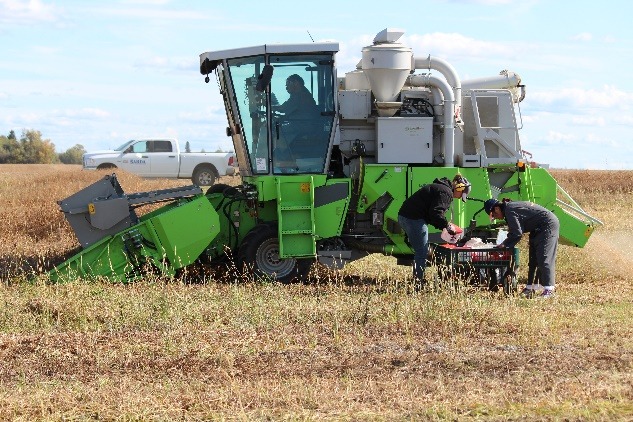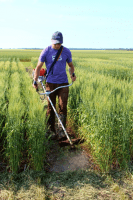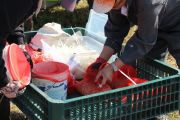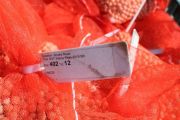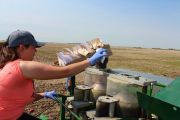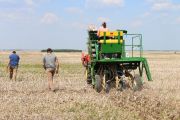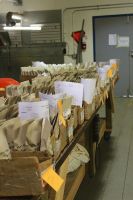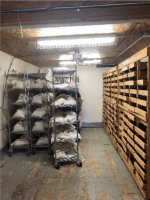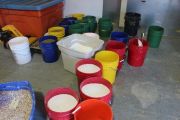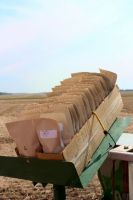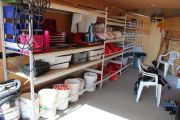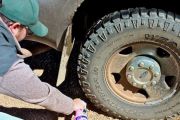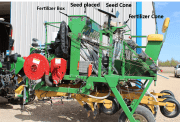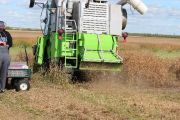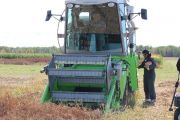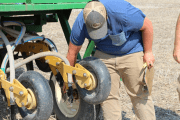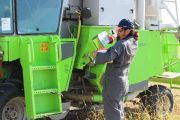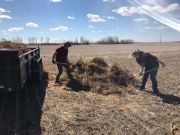Have you ever wondered why it takes SARDA so long to do its plot work? Why do we need so many workers and what the heck are we doing out there? The plots are only small. Harvest is upon us and I thought it would be a great time to tell you what is involved in completing a simple trial.
The first action in any successful trial is site selection. Landowners are contacted to ensure that they are agreeable to having plots on their land. Potential fields are scouted and assessed for location, slope, soil type and cropping history. The potential site location should not be in the headlands and should allow for the land owner to easily operate equipment around the area. It is also very desirable to be away from trees and wetlands which are often home to local wildlife. SARDA trial areas are on the highest productive land available as this encourages the expression of the desired genetics or treatment. Once a location is chosen, the area is flagged and composite soil samples are taken on the area to determine fertility requirements and ensure the site is free from any soil borne diseases. Protocols of the trials planned for the area are reviewed to ensure there are no special requirements. Residue issues are eliminated and appropriate pre-seed burn-offs are applied.
During the time the site is being prepared, a lot of work is going on in the office and the shop. Seeding maps are created for the sites and each trials. Fertility rates are calculated and blends created. Seed is acquired, germination tested, treated if required, weighed and packaged. The weight of each seed package is calculated by using the plot size, desired plant density, the thousand kernel weight (TKW) and the germination. Fertilizer package weights are usually determined based on plot size and the protocols of the trial that indicate the fertilizer rates to be used. Packages are sorted and placed in boxes according to the order they will be seeded in the field. For trials that are not assessing fertility, we are able to use a common blend and apply it using the fertilizer boxes on the drill. For those trials that are assessing fertility treatments, the fertilizer components are weighed individually and placed into fertilizer envelopes that will be applied using the cones on the seed drill. Throughout the entire process of package preparation, everything is checked and rechecked to ensure that they are prepared in accordance to the trial protocols. All data are recorded and entered into the computer.
So now the seed, fertilizer and sites are prepared, it is time to load the freshly serviced and calibrated seeding equipment to the site. The drill is unloaded from the trailer, the seed and fertilizer loaded, settings adjusted and staff directed to their positions. It takes several staff to seed a trial. One staff member is in charge of checking the trial protocols, the seed and/or fertility packages, the settings on the seed drill and the location within the site where the trial is slated to be seeded. Weather and temperature information is recorded. One staff is required to drive the tractor and one or two staff are placed on the drill to add the different packages to the cones. One staff walks beside the drill and calls out the when to trip the control to add the seed and/or fertilizer. To start seeding, the unit is lined up to seed the guard and the operation commences. After the first plot is seeded, seed placement is assessed for depth, coverage and packing pressure. Settings are fine-tuned on the drill. The seeding operation continues. SARDA uses RTK technology to align and space the plots to an accuracy of less than an inch variance. After seeding each trial, stakes are added to ensure people know what is seeded and where the alleys are to be put. Before each trial, all settings are checked, recorded and the new trial inputs loaded.
Guards are seeded before and after each trial ensuring separation and to protect the end plots from edge effects of climate. They are the same crop as the trials and are usually unlabeled. These guards are used all season long to test or set equipment, and stage crops.
Once the seeding is completed, many trials call for plant counts to assess germination and plant stand density. With some trials, plants will need to be counted several times during the season. In this picture, summer staff are counting newly germinated plants in the plots.
In addition to maintaining the plots, all sites need maintenance which includes, seeding between the plots, mowing several times per season, and labelling and signing the different plots and trials. Sites are open to the public throughout the season and people are encouraged to visit and view the trials.
During all operations on the sites, a strict biosecurity protocol is adhered to. Equipment is washed and disinfected after every operation. If the site is wet, operations are postponed until mud is not an issue if at all possible while protocols are followed. Staff use the same work boots all summer which are cleaned and disinfected regularly. Disposable booties are supplied to all visitors at the sites.
Like all farmers, we look forward to harvest. In late summer, maturities of the various crops are assessed and desiccation commences. When ready, the combine is loaded and taken to the site. Once again the guards are used to set and calibrate the equipment. The combine is specialized. Not only is it extremely small as compared to the units used by the producers of the area, it also has the ability to weigh the yield from each plot, separate a representative sample, and take the moisture of the samples. After each plot, the combine cycles through an air cleaning cycle to ensure there is no mixing of samples. Information is saved to a tablet which is downloaded to the computers at the office. The subsamples are loaded into the mobile lab and returned to the shop located in Falher. Once at the shop, they are loaded into the racks in the drying room, where the moisture content will be reduced and equalized. Below is a montage of photos taken during the harvest of the Regional Variety Trial of field pea.
by Shelleen Gerbig, P.Ag, SARDA Ag Research

